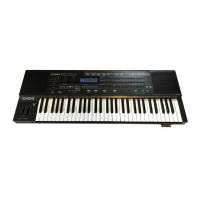Sound
Synthesis
Techniques
ABOUT
PARAMETERS
_&
VALUES
- L _
HT-6000 tones are made up
of
a variety
of
"parameters."
These parameters determine the characferistics
of
each ·
individual
sou
!il
d, including such elements
as
.timbre,
11
pitch
and volume.
To edit
or
·synthesize new sounds, you simply alter the
"values"
(numeric)
of
a single
or
multiple parameters.
When
the HT-6000 stores
"new"
sounds, or sounds you
have altered through sound editing, it
is
actually storing and
recalling the values you have assigned to all the related
parameters.
-=-,
r -
A list
of
these parameters and the range
of
values which may
be
set
for them ,
is
shown in the parameter index on
page
27
.
EDITING
&
WRITING
TONES
To create sounds on the HT-6000, you simply change, or
"edit"
preset tone parameters.
It's not necessary to start with a " blank slate" w
en
creating
a new tone. The easiest approa
1=
h
is
to first si
le
9: ~ factory
preset tone that resembles the ¢
ne
you
hav~
i,Q
0
,
rr,
ind
and
edit that sound until you get the sound you
3
vvlf
n
f.
.>.H
TONE
EDITING
HT-6000 tones can
be
edited
by altering the values
of
t~eir
parameters. This process
1s
known
as
"TONE
EDITING"·
•
To
edit tones
(!)Select the tone to
be
edited.
* Note
that
both upper and
lower tones may be edited.
BRASS
ENS
-
4 14
c::::J
SVNTH-
BAASS
- 24-
Mode dial
*
The
mode·
dial
is
used
to
I
C
't parameter numbers.
see
, ,
I • '
I'
Tempo/data dial
. * The tempo/data
dial
is
'
u
s~
d
to
input a
va
/ ue (
or
,
the _selected parameter ·
, Parameter number , . '
-,,
1
1,
!1
Value
TEMPO ~ n
\'b':e-=!
U ' 11
"""'"'u'NIT
LINE2
"I'i'NE'i
LINE
4
*
Parameter
numbers
are
displayed
in
the
MODE
position on the
LCD
display.
*
Values
are
displayed
in
the
DATA
position .

